child restraint TOYOTA C-HR 2019 Owners Manual (in English)
[x] Cancel search | Manufacturer: TOYOTA, Model Year: 2019, Model line: C-HR, Model: TOYOTA C-HR 2019Pages: 532, PDF Size: 10.35 MB
Page 2 of 532
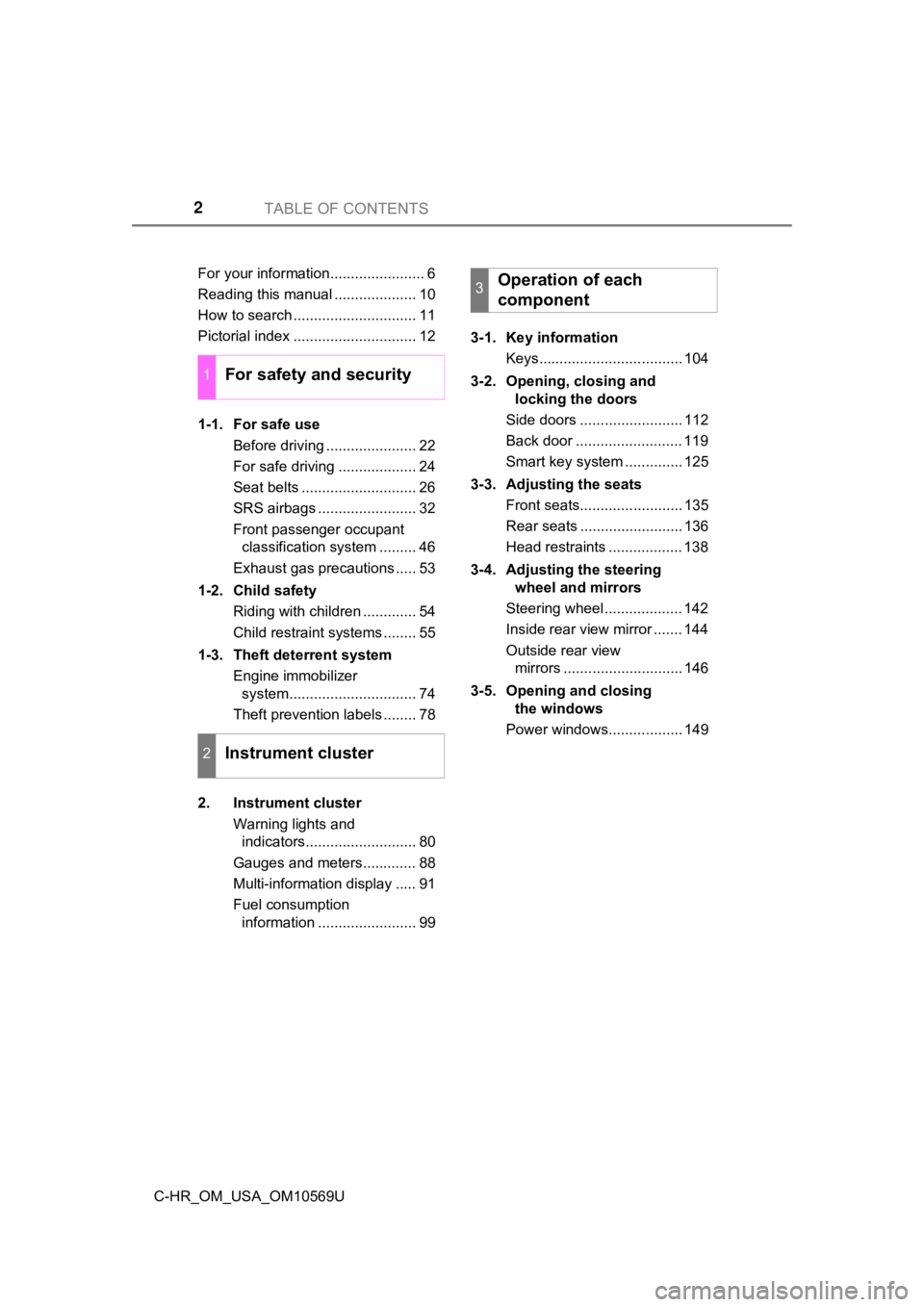
TABLE OF CONTENTS2
C-HR_OM_USA_OM10569UFor your information....................... 6
Reading this manual .................... 10
How to search .............................. 11
Pictorial index .............................. 12
1-1. For safe use
Before driving ...................... 22
For safe driving ................... 24
Seat belts ............................ 26
SRS airbags ........................ 32
Front passenger occupant classification system ......... 46
Exhaust gas precautions ..... 53
1-2. Child safety Riding with children ............. 54
Child restraint systems ........ 55
1-3. Theft deterrent system Engine immobilizer system............................... 74
Theft prevention labels ........ 78
2. Instrument cluster Warning lights and indicators........................... 80
Gauges and meters............. 88
Multi-information display ..... 91
Fuel consumption information ........................ 99 3-1. Key information
Keys................................... 104
3-2. Opening, closing and locking the doors
Side doors ......................... 112
Back door .......................... 119
Smart key system .............. 125
3-3. Adjusting the seats Front seats......................... 135
Rear seats ......................... 136
Head restraints .................. 138
3-4. Adjusting the steering wheel and mirrors
Steering wheel ................... 142
Inside rear view mirror ....... 144
Outside rear view mirrors ............................. 146
3-5. Opening and closing the windows
Power windows.................. 149
1For safety and security
2Instrument cluster
3Operation of each
component
Page 21 of 532
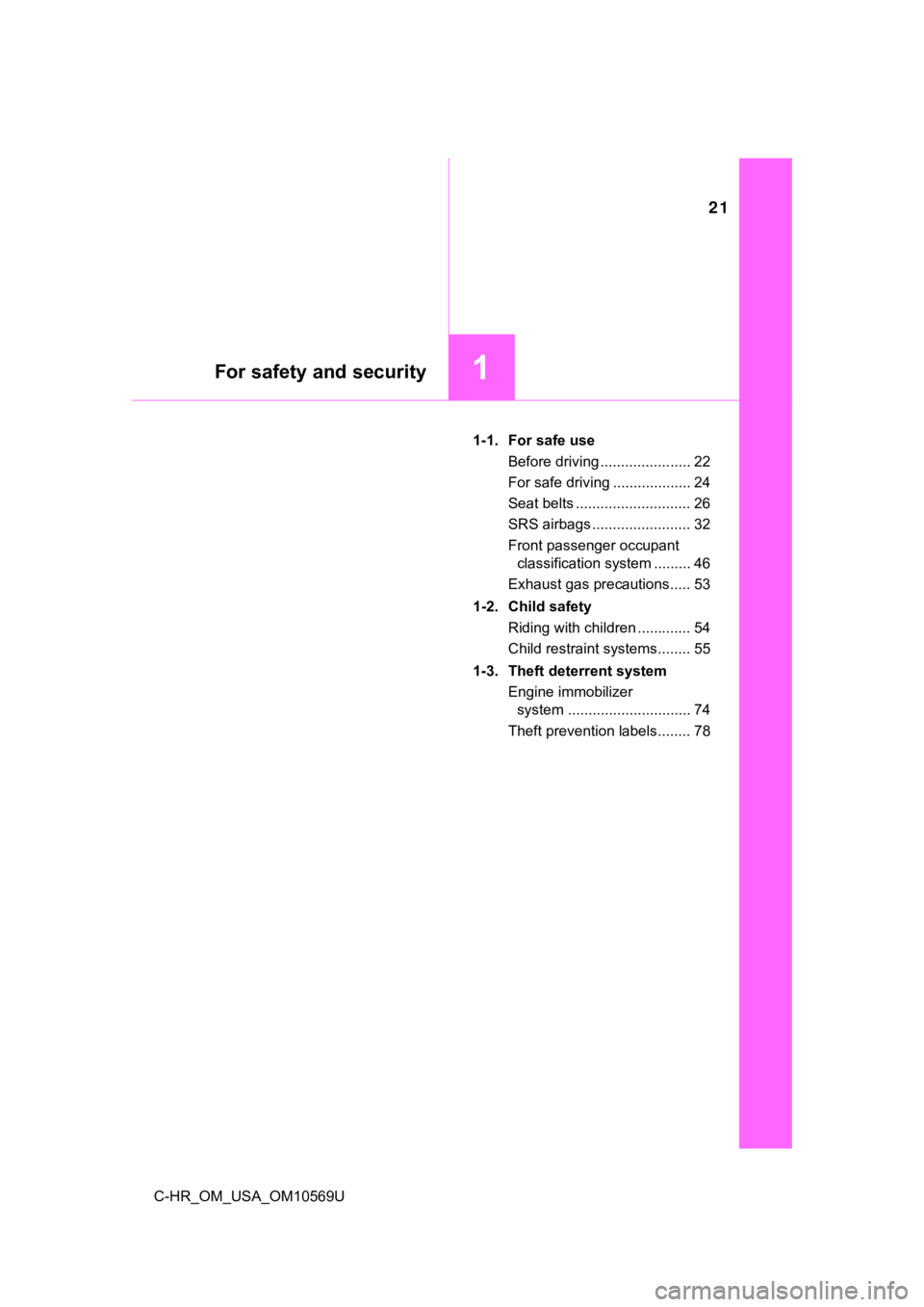
21
For safety and security1
C-HR_OM_USA_OM10569U1-1. For safe use
Before driving ...................... 22
For safe driving ................... 24
Seat belts ............................ 26
SRS airbags ........................ 32
Front passenger occupant classification system ......... 46
Exhaust gas precautions..... 53
1-2. Child safety Riding with children ............. 54
Child restraint systems........ 55
1-3. Theft deterrent system Engine immobilizer system .............................. 74
Theft prevention labels........ 78
Page 24 of 532
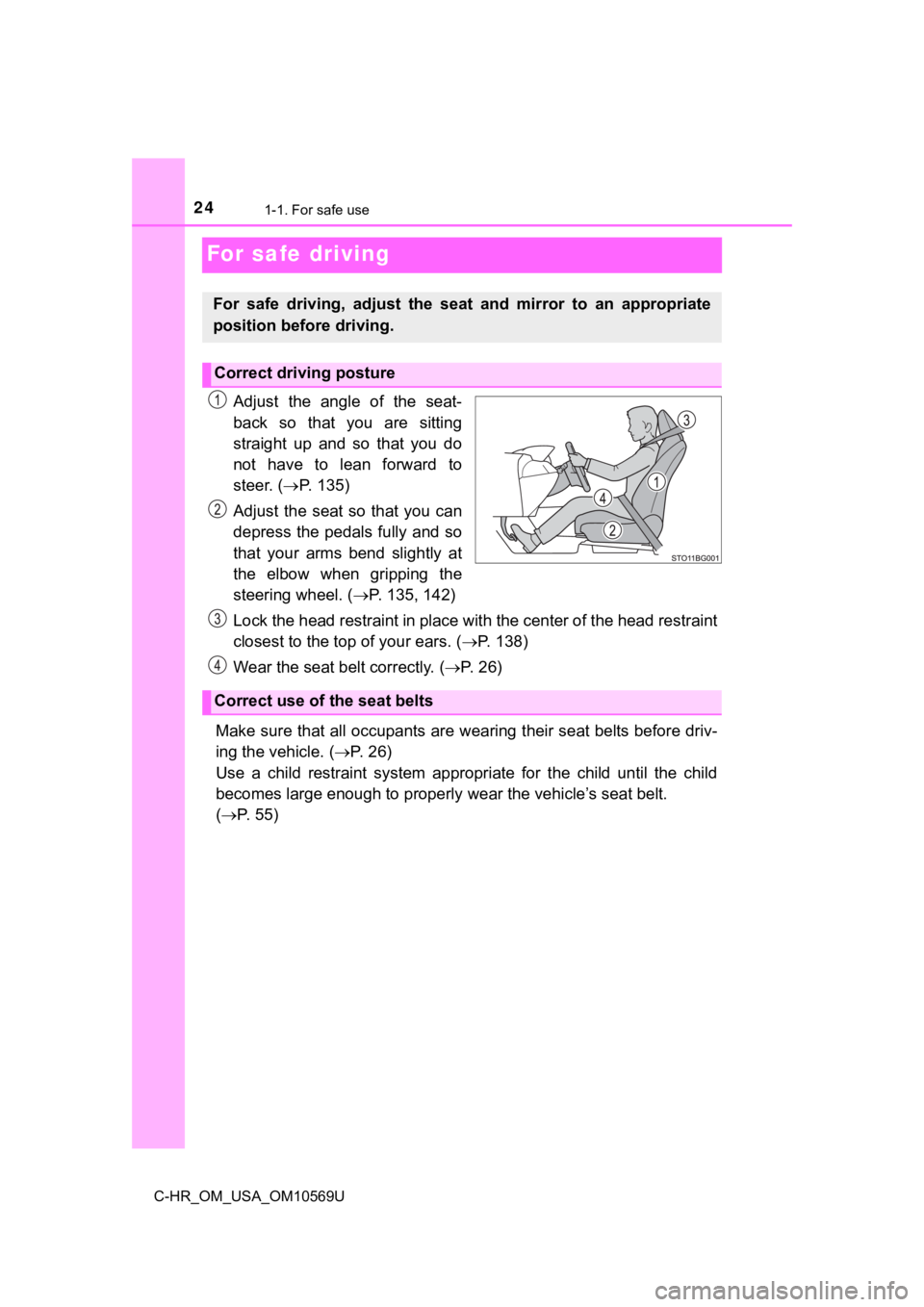
241-1. For safe use
C-HR_OM_USA_OM10569U
For safe driving
Adjust the angle of the seat-
back so that you are sitting
straight up and so that you do
not have to lean forward to
steer. (P. 1 3 5 )
Adjust the seat so that you can
depress the pedals fully and so
that your arms bend slightly at
the elbow when gripping the
steering wheel. ( P. 135, 142)
Lock the head restraint in place with the center of the head restraint
closest to the top of your ears. ( P. 1 3 8 )
Wear the seat belt correctly. ( P. 2 6 )
Make sure that all occupants are wearing their seat belts before driv-
ing the vehicle. ( P. 2 6 )
Use a child restraint system appropriate for the child until th e child
becomes large enough to properly wear the vehicle’s seat belt.
( P. 55)
For safe driving, adjust the seat and mirror to an appropriate
position before driving.
Correct driving posture
Correct use of the seat belts
Page 28 of 532
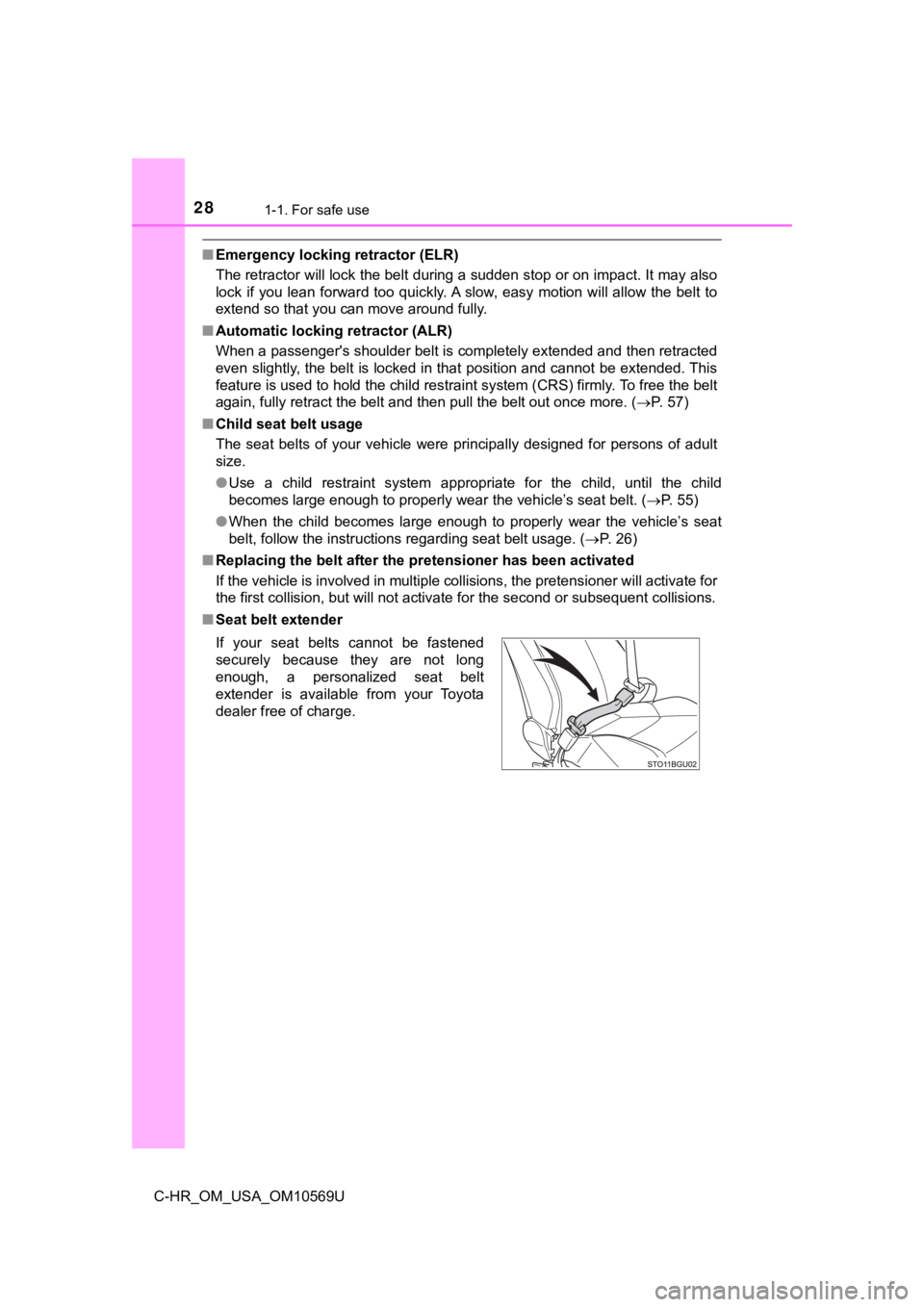
281-1. For safe use
C-HR_OM_USA_OM10569U
■Emergency locking retractor (ELR)
The retractor will lock the belt during a sudden stop or on imp act. It may also
lock if you lean forward too quickly. A slow, easy motion will allow the belt to
extend so that you can move around fully.
■ Automatic locking retractor (ALR)
When a passenger's shoulder belt is completely extended and the n retracted
even slightly, the belt is locked in that position and cannot be extended. This
feature is used to hold the child restraint system (CRS) firmly . To free the belt
again, fully retract the belt and then pull the belt out once m ore. (P. 57)
■ Child seat belt usage
The seat belts of your vehicle were principally designed for persons of adult
size.
●Use a child restraint system appropriate for the child, until the child
becomes large enough to properly wear the vehicle’s seat belt. ( P. 55)
● When the child becomes large enough to properly wear the vehicle’s seat
belt, follow the instructions regarding seat belt usage. ( P. 26)
■ Replacing the belt after the pr etensioner has been activated
If the vehicle is involved in multiple collisions, the pretensi oner will activate for
the first collision, but will not activate for the second or su bsequent collisions.
■ Seat belt extender
If your seat belts cannot be fastened
securely because they are not long
enough, a personalized seat belt
extender is available from your Toyota
dealer free of charge.
Page 29 of 532
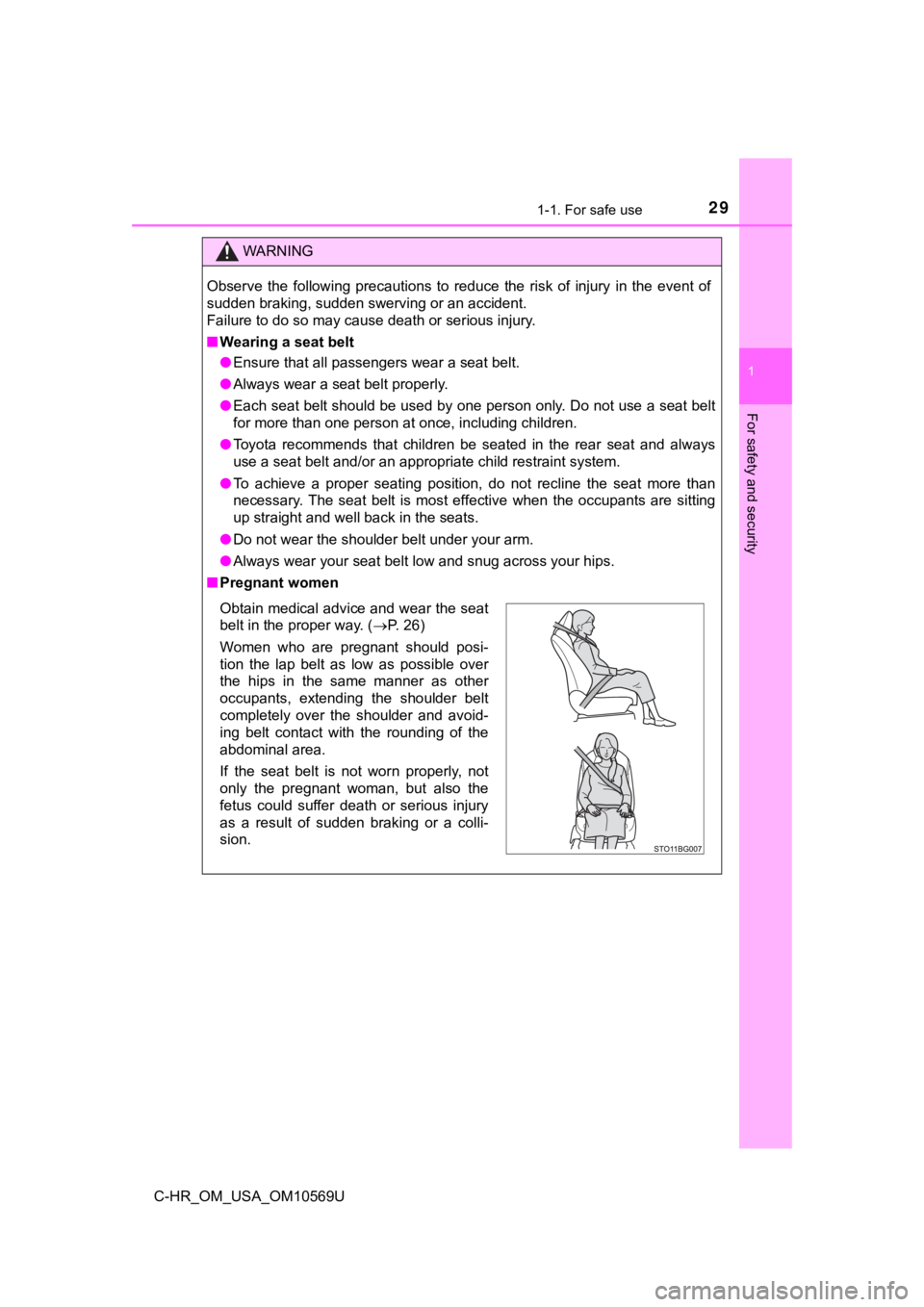
291-1. For safe use
1
For safety and security
C-HR_OM_USA_OM10569U
WARNING
Observe the following precautions to reduce the risk of injury in the event of
sudden braking, sudden swerving or an accident.
Failure to do so may cause death or serious injury.
■ Wearing a seat belt
● Ensure that all passengers wear a seat belt.
● Always wear a seat belt properly.
● Each seat belt should be used by one person only. Do not use a seat belt
for more than one person at once, including children.
● Toyota recommends that children be seated in the rear seat and always
use a seat belt and/or an appropriate child restraint system.
● To achieve a proper seating position, do not recline the seat m ore than
necessary. The seat belt is most effective when the occupants a re sitting
up straight and well back in the seats.
● Do not wear the shoulder belt under your arm.
● Always wear your seat belt low and snug across your hips.
■ Pregnant women
Obtain medical advice and wear the seat
belt in the proper way. ( P. 26)
Women who are pregnant should posi-
tion the lap belt as low as possible over
the hips in the same manner as other
occupants, extending the shoulder belt
completely over the shoulder and avoid-
ing belt contact with the rounding of the
abdominal area.
If the seat belt is not worn properly, not
only the pregnant woman, but also the
fetus could suffer death or serious injury
as a result of sudden braking or a colli-
sion.
Page 31 of 532
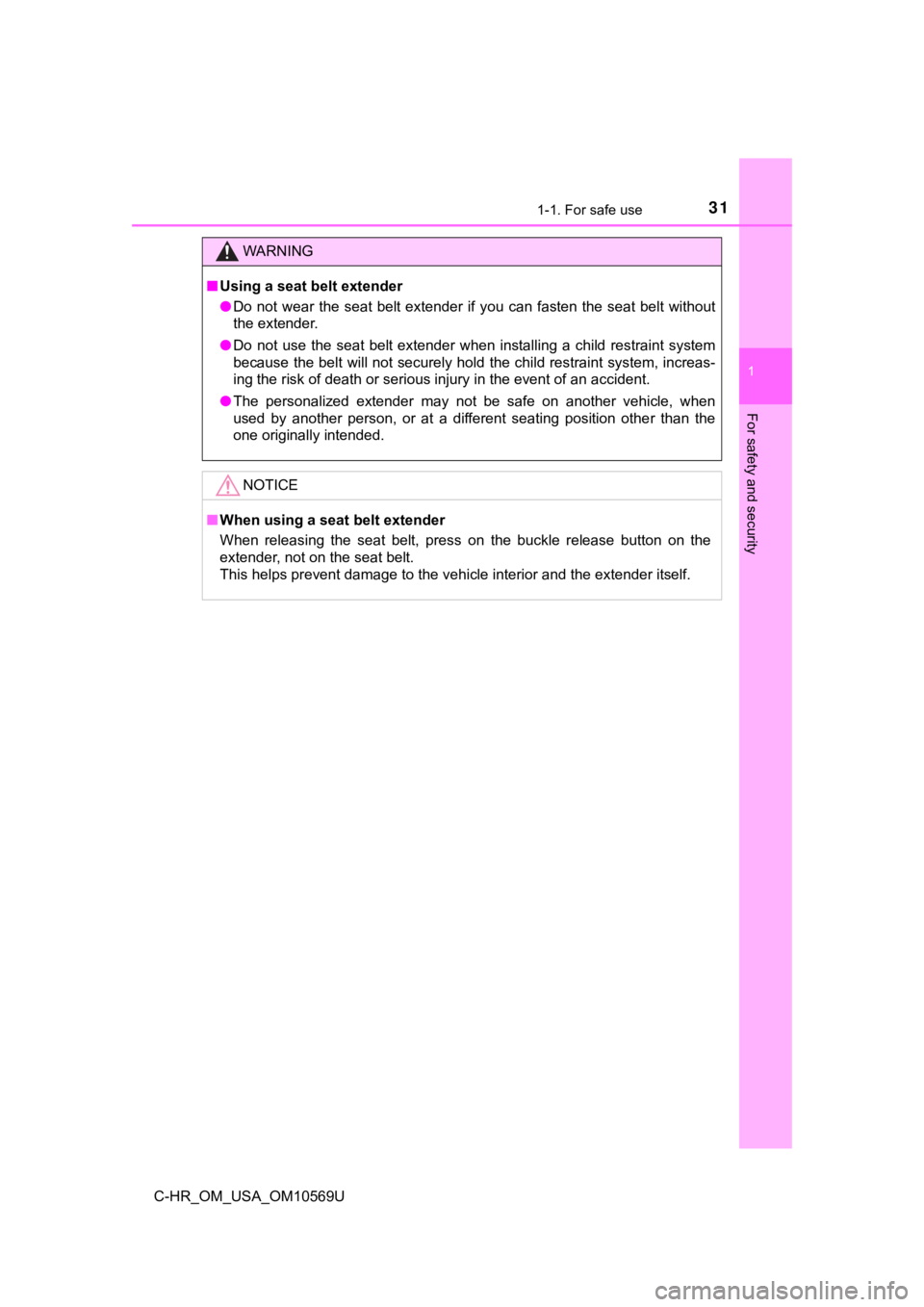
311-1. For safe use
1
For safety and security
C-HR_OM_USA_OM10569U
WARNING
■Using a seat belt extender
● Do not wear the seat belt extender if you can fasten the seat belt without
the extender.
● Do not use the seat belt extender when installing a child restr aint system
because the belt will not securely hold the child restraint system, increas-
ing the risk of death or serious injury in the event of an acci dent.
● The personalized extender may not be safe on another vehicle, when
used by another person, or at a different seating position othe r than the
one originally intended.
NOTICE
■ When using a seat belt extender
When releasing the seat belt, press on the buckle release butto n on the
extender, not on the seat belt.
This helps prevent damage to the vehicle interior and the extender itself.
Page 49 of 532
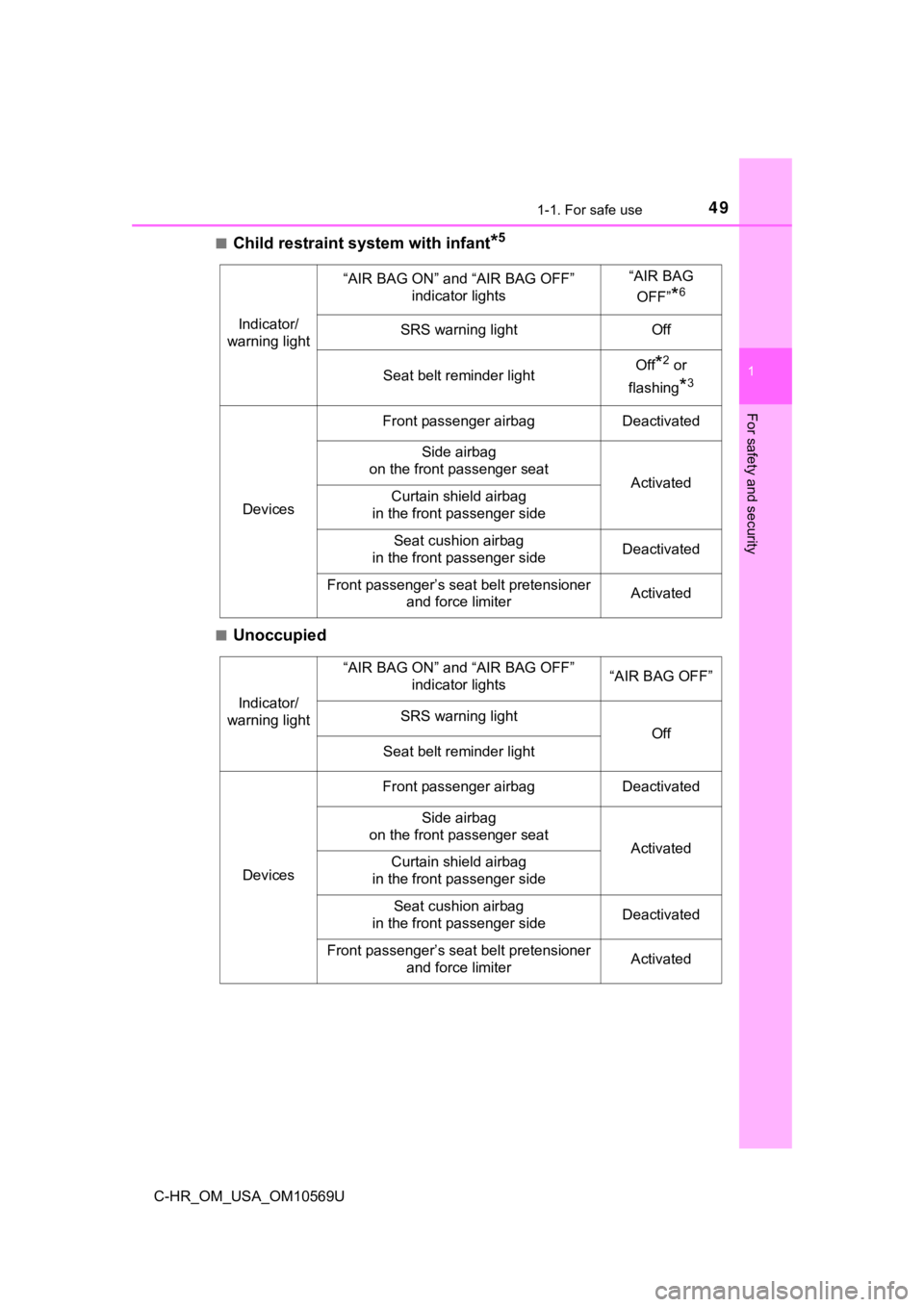
491-1. For safe use
1
For safety and security
C-HR_OM_USA_OM10569U■
Child restraint system with infant*5
■Unoccupied
Indicator/
warning light
“AIR BAG ON” and “AIR BAG OFF”
indicator lights“AIR BAG
OFF”
*6
SRS warning lightOff
Seat belt reminder lightOff*2 or
flashing
*3
Devices
Front passenger airbagDeactivated
Side airbag
on the front passenger seat
ActivatedCurtain shield airbag
in the front passenger side
Seat cushion airbag
in the front passenger sideDeactivated
Front passenger’s seat belt pretensioner and force limiterActivated
Indicator/
warning light
“AIR BAG ON” and “AIR BAG OFF” indicator lights“AIR BAG OFF”
SRS warning light
Off
Seat belt reminder light
Devices
Front passenger airbagDeactivated
Side airbag
on the front passenger seat
ActivatedCurtain shield airbag
in the front passenger side
Seat cushion airbag
in the front passenger sideDeactivated
Front passenger’s seat belt pretensioner and force limiterActivated
Page 50 of 532
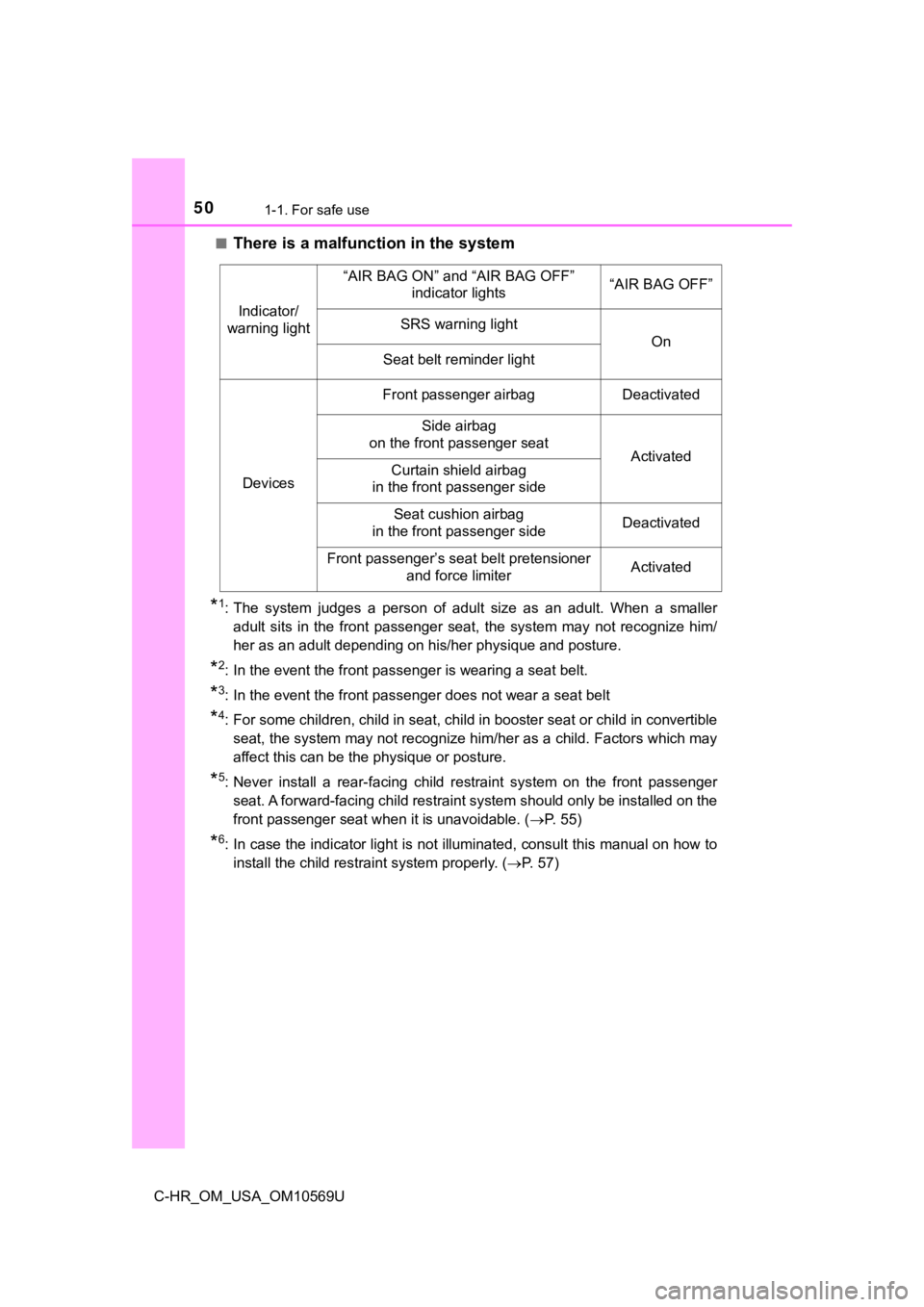
501-1. For safe use
C-HR_OM_USA_OM10569U■
There is a malfunction in the system
*1: The system judges a person of adult size as an adult. When a s
maller
adult sits in the front passenger seat, the system may not recognize him/
her as an adult depending on his/her physique and posture.
*2: In the event the front passenger is wearing a seat belt.
*3: In the event the front passenger does not wear a seat belt
*4: For some children, child in seat, child in booster seat or chi ld in convertible
seat, the system may not recognize him/her as a child. Factors which may
affect this can be the physique or posture.
*5: Never install a rear-facing child restraint system on the front passenger seat. A forward-facing child restraint system should only be in stalled on the
front passenger seat when it is unavoidable. ( P. 55)
*6: In case the indicator light is not illuminated, consult this m anual on how to
install the child restraint system properly. ( P. 57)
Indicator/
warning light
“AIR BAG ON” and “AIR BAG OFF” indicator lights“AIR BAG OFF”
SRS warning light
On
Seat belt reminder light
Devices
Front passenger airbagDeactivated
Side airbag
on the front passenger seat
ActivatedCurtain shield airbag
in the front passenger side
Seat cushion airbag
in the front passenger sideDeactivated
Front passenger’s seat belt pretensioner and force limiterActivated
Page 52 of 532
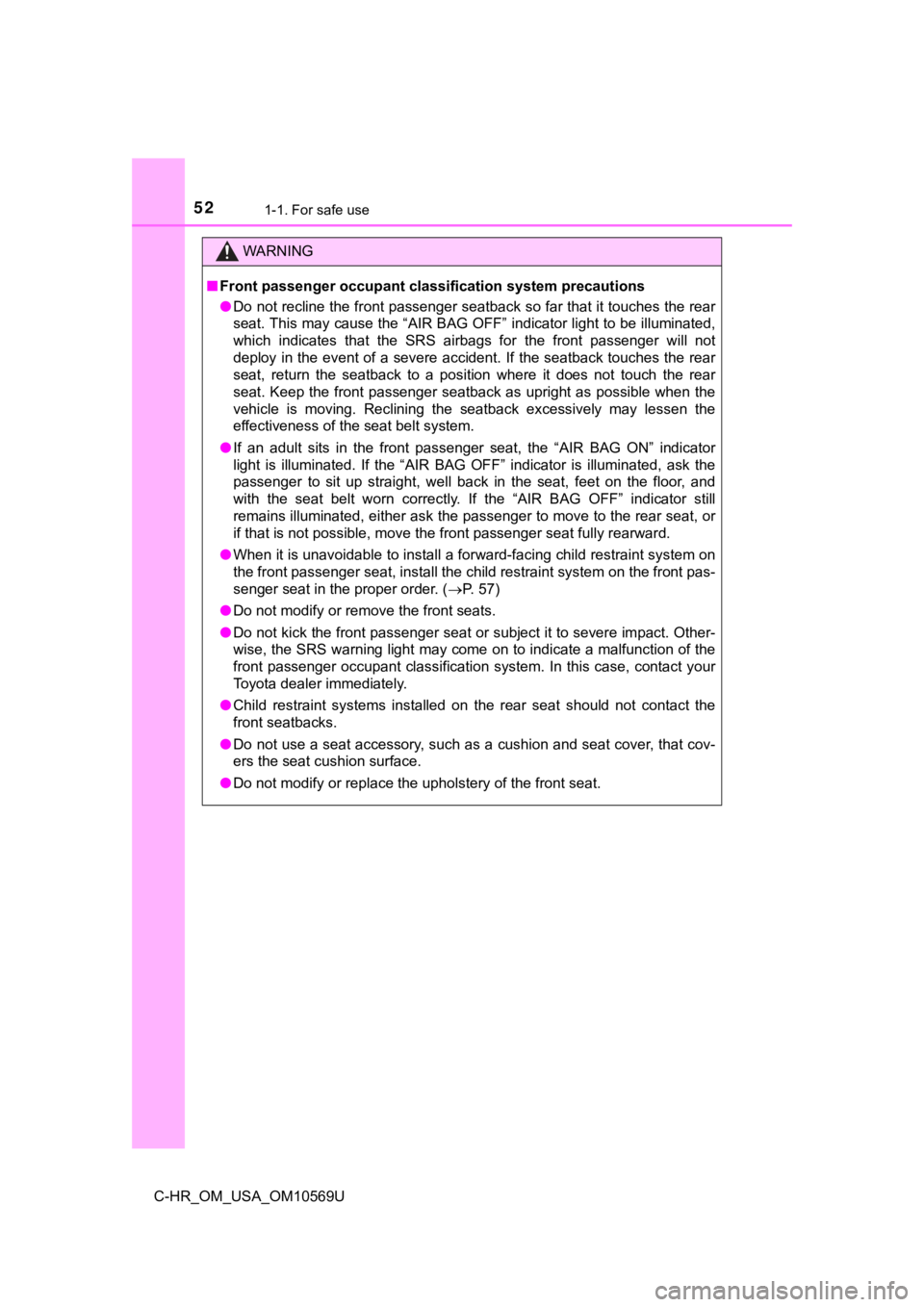
521-1. For safe use
C-HR_OM_USA_OM10569U
WARNING
■Front passenger occupant classification system precautions
● Do not recline the front passenger seatback so far that it touches the rear
seat. This may cause the “AIR BAG OFF” indicator light to be il luminated,
which indicates that the SRS airbags for the front passenger wi ll not
deploy in the event of a severe accident. If the seatback touch es the rear
seat, return the seatback to a position where it does not touch the rear
seat. Keep the front passenger seatback as upright as possible when the
vehicle is moving. Reclining the seatback excessively may lesse n the
effectiveness of the seat belt system.
● If an adult sits in the front passenger seat, the “AIR BAG ON” indicator
light is illuminated. If the “AIR BAG OFF” indicator is illuminated, ask the
passenger to sit up straight, well back in the seat, feet on the floor, and
with the seat belt worn correctly. If the “AIR BAG OFF” indicat or still
remains illuminated, either ask the passenger to move to the re ar seat, or
if that is not possible, move the front passenger seat fully re arward.
● When it is unavoidable to install a forward-facing child restra int system on
the front passenger seat, install the child restraint system on the front pas-
senger seat in the proper order. ( P. 57)
● Do not modify or remove the front seats.
● Do not kick the front passenger seat or subject it to severe im pact. Other-
wise, the SRS warning light may come on to indicate a malfuncti on of the
front passenger occupant classification system. In this case, contact your
Toyota dealer immediately.
● Child restraint systems installed on the rear seat should not c ontact the
front seatbacks.
● Do not use a seat accessory, such as a cushion and seat cover, that cov-
ers the seat cushion surface.
● Do not modify or replace the upholstery of the front seat.
Page 54 of 532
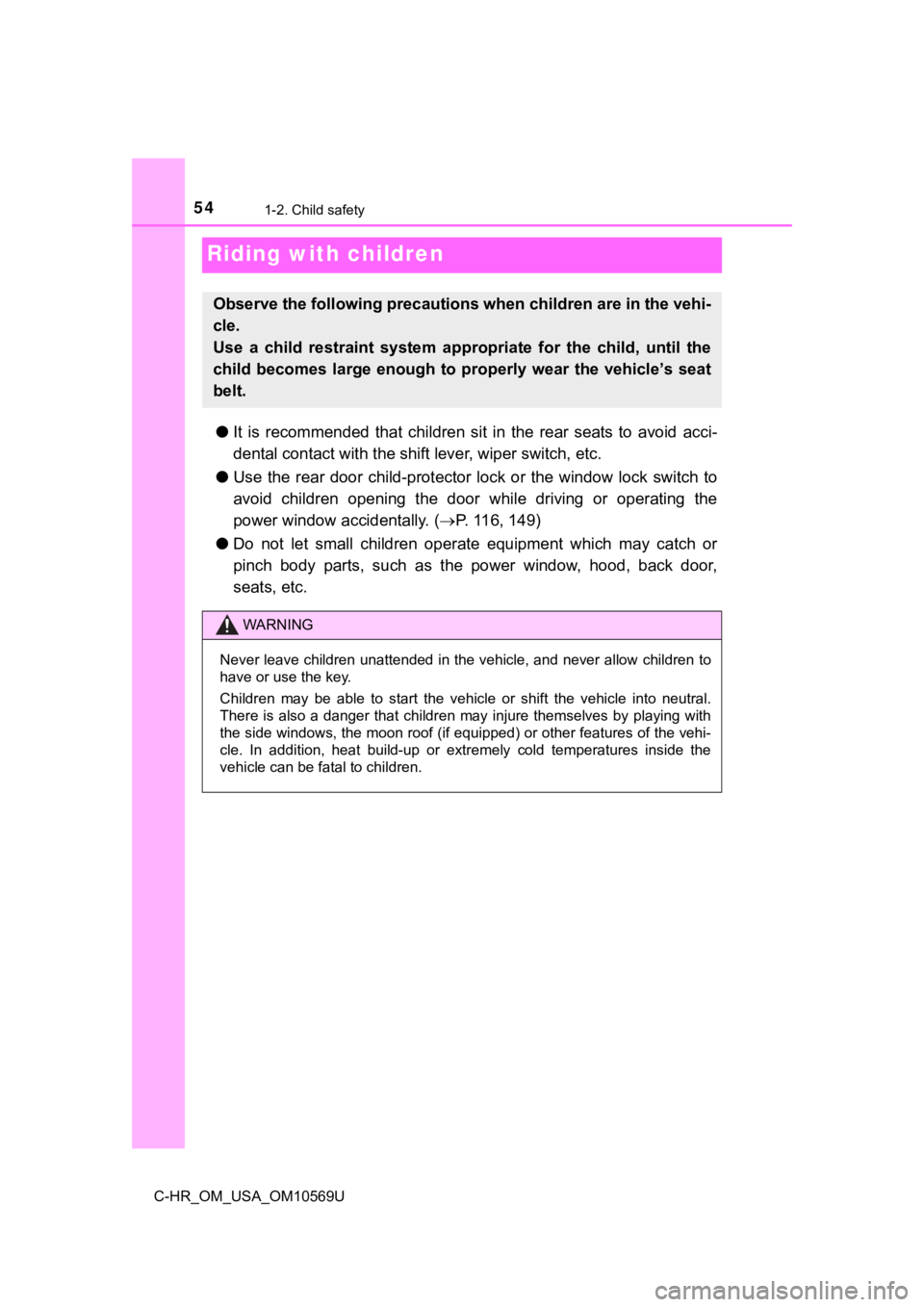
541-2. Child safety
C-HR_OM_USA_OM10569U
Riding with children
●It is recommended that children sit in the rear seats to avoid acci-
dental contact with the shift lever, wiper switch, etc.
● Use the rear door child-protector lock or the window lock switc h to
avoid children opening the door while driving or operating the
power window accidentally. ( P. 116, 149)
● Do not let small children operate equipment which may catch or
pinch body parts, such as the power window, hood, back door,
seats, etc.
Observe the following precautions when children are in the vehi -
cle.
Use a child restraint system app ropriate for the child, until the
child becomes large enough to properly wear the vehicle’s seat
belt.
WARNING
Never leave children unattended in the vehicle, and never allow children to
have or use the key.
Children may be able to start the vehicle or shift the vehicle into neutral.
There is also a danger that children may injure themselves by p laying with
the side windows, the moon roof (if equipped) or other features of the vehi-
cle. In addition, heat build-up or extremely cold temperatures inside the
vehicle can be fatal to children.